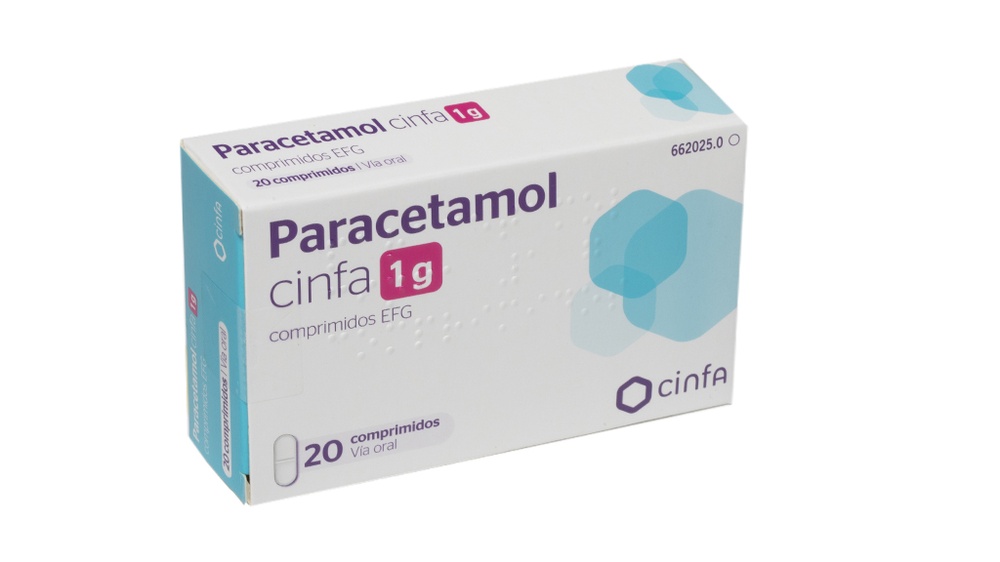

PARACETAMOL CINFA 1 g TABLETS

Ask a doctor about a prescription for PARACETAMOL CINFA 1 g TABLETS

How to use PARACETAMOL CINFA 1 g TABLETS
Introduction
Package Leaflet: Information for the User
Paracetamol Cinfa1 gEFG Tablets
Read the entire package leaflet carefully before starting to take this medication, as it contains important information for you.
- Keep this package leaflet, as you may need to read it again.
- If you have any questions, consult your doctor or pharmacist.
- This medication has been prescribed to you only, and you should not give it to others, even if they have the same symptoms as you, as it may harm them.
- If you experience side effects, consult your doctor or pharmacist, even if they are side effects not listed in this package leaflet. See section 4.
Contents of the Package Leaflet
- What Paracetamol Cinfa is and what it is used for
- What you need to know before taking Paracetamol Cinfa
- How to take Paracetamol Cinfa
- Possible side effects
- Storage of Paracetamol Cinfa
Package Contents and Additional Information
1. What Paracetamol Cinfa is and what it is used for
Paracetamol Cinfa belongs to the group of medications called analgesics and antipyretics.
This medication is used for the symptomatic treatment of mild or moderate pain and fever in adults and adolescents over 15 years of age and weighing more than 50 kg.
2. What you need to know before taking Paracetamol Cinfa
Do not take Paracetamol Cinfa
- If you are allergic to paracetamol or any of the other components of this medication (listed in section 6).
Warnings and Precautions
Consult your doctor or pharmacist before starting to take Paracetamol Cinfa.
- Do not take more than the recommended dose in section 3, "How to take Paracetamol Cinfa".
- Avoid taking this medication simultaneously with other medications that contain paracetamol, such as medications for flu and colds, as high doses can cause liver damage. Do not use more than one medication that contains paracetamol without consulting your doctor.
- Chronic alcoholics should be cautious not to take more than 2 g/24 hours of paracetamol.
- Patient with kidney disease due to its paracetamol content of 1 g cannot take this medication. Those suffering from liver, heart, or lung disease and patients with anemia should consult their doctor before taking this medication.
- When being treated with medication for epilepsy, consult your doctor before taking this medication, as the efficacy of paracetamol may be decreased and hepatotoxicity may be increased, especially in high-dose treatments.
- Inform your doctor before taking this medication if you are an asthmatic patient sensitive to acetylsalicylic acid.
- Paracetamol can cause severe skin reactions, such as acute generalized exanthematous pustulosis(AGEP), Stevens-Johnson syndrome (SJS), and toxic epidermal necrolysis (TEN), which can be fatal. Patients should be informed about the signs of severe skin reactions and should discontinue the use of the medication at the first symptom of skin rash or any other sign of hypersensitivity.
- If you have severe diseases, such as severe renal failure or sepsis (when bacteria and their toxins circulate in the blood, causing damage to organs), or if you suffer from malnutrition, chronic alcoholism, or are also taking flucloxacillin (an antibiotic). A severe disease called metabolic acidosis (an anomaly in blood and fluids) has been reported in patients in these situations when paracetamol is used at regular doses for a prolonged period or when paracetamol is taken with flucloxacillin. The symptoms of metabolic acidosis may include: severe breathing difficulties with deep and rapid breathing, drowsiness, feeling of discomfort (nausea) and vomiting.
Children and Adolescents
Due to the dose of paracetamol, this medication should not be used in children or adolescents under 15 years of age (and weighing less than 50 kg). Ask your doctor or pharmacist about the available presentations that allow for adequate dosing of these patients.
Interference with Analytical Tests
If you are going to undergo any analytical tests (including blood, urine, etc.), inform your doctor that you are taking this medication, as it may alter the results.
Paracetamol may alter the values of analytical determinations of uric acid and glucose.
Other Medications and Paracetamol Cinfa
Inform your doctor or pharmacist if you are taking, have recently taken, or may need to take any other medication.
In particular, if you are taking any of the following medications, it may be necessary to modify the dose of some of them or interrupt treatment:
- Medication to prevent blood clots: oral anticoagulants (acenocoumarol, warfarin).
- Medications for treating epilepsy: antiepileptics (lamotrigine, phenytoin or other hydantoins, phenobarbital, methylphenobarbital, primidone, carbamazepine).
- Medications for treating tuberculosis: (isoniazid, rifampicin).
- Medications for treating depression and convulsions: barbiturates (used as hypnotics, sedatives, and anticonvulsants).
- Medications for reducing cholesterol levels in the blood (cholestyramine).
- Medications used to increase urine elimination (loop diuretics such as furosemide).
- Medications used for the treatment of gout (probenecid and sulfinpyrazone).
- Medications used to prevent nausea and vomiting: metoclopramide and domperidone.
- Medications used in the treatment of high blood pressure and heart rhythm disorders (arrhythmias): propranolol.
Also, inform your doctor or pharmacist if you are taking:
flucloxacillin (antibiotic), due to a serious risk of alteration of blood and fluids (called metabolic acidosis with high anion gap) that should be treated urgently (see section 2).
Taking Paracetamol Cinfa with Food, Drinks, and Alcohol
Taking paracetamol in patients who habitually consume alcohol (three or more alcoholic beverages per day: beer, wine, liquor) can cause liver damage.
Taking this medication with food does not affect its efficacy.
Pregnancy and Breastfeeding
If you are pregnant or breastfeeding, think you may be pregnant, or plan to become pregnant, consult your doctor or pharmacist before using this medication.
If necessary, paracetamol can be used during pregnancy. You should use the lowest possible dose that reduces pain or fever and use it for the shortest possible time. Contact your doctor if the pain or fever does not decrease or if you need to take the medication more frequently.
Paracetamol passes into breast milk, so breastfeeding women should consult their doctor or pharmacist before taking this medication.
Driving and Using Machines
The influence of paracetamol on the ability to drive and use machines is zero or insignificant.
3. How to Take Paracetamol Cinfa
Follow the administration instructions of this medication exactly as indicated by your doctor or pharmacist. If in doubt, consult your doctor or pharmacist again.
This medication is taken orally.
According to your preferences, the tablets can be swallowed directly or broken in half, with the help of a glass of liquid, preferably water.
The recommended dose is:
Adults and Adolescents Over 15 Years of Age (and Weighing More Than 50 kg)
The recommended dose is 1 or half a tablet (1 g-500 mg of paracetamol) as needed. The doses should be spaced at least 4 hours apart. Do not take more than 4 tablets (4 g) in 24 hours.
Elderly Patients
Your doctor will indicate the frequency and whether the dose needs to be reduced.
Patient with Liver Disease
They should take the prescribed amount of medication by their doctor with a minimum interval between each dose of 8 hours. They should not take more than 2 grams of paracetamol in 24 hours, divided into 2 doses.
Patient with Kidney Disease
Before taking this medication, they must consult their doctor. Take a maximum of half a tablet (500 milligrams) per dose. According to their disease, their doctor will indicate whether they should take their medication with a minimum interval of 6 or 8 hours.
They should not take more than 2 grams in 24 hours, divided into several doses, not exceeding 500 milligrams per dose in any case.
Use in Children and Adolescents
Do not use in children under 15 years of age.
The tablet can be broken into equal doses.
Taking this medication is subject to the appearance of symptoms, pain, or fever. As these symptoms disappear, treatment should be discontinued.
Avoid using high daily doses of paracetamol for prolonged periods, as this increases the risk of suffering from side effects such as liver damage.
If the pain persists for more than 5 days, the fever for more than 3 days, or the pain or fever worsens or other symptoms appear, consult your doctor and reevaluate the clinical situation.
If You Take More Paracetamol Cinfa Than You Should
In case of overdose or accidental ingestion, consult your doctor or pharmacist immediately or call the Toxicology Information Service, phone 91 562 04 20, indicating the medication and the amount ingested.
The symptoms of overdose may be: dizziness, vomiting, loss of appetite, yellowing of the skin and eyes (jaundice), and abdominal pain.
If you have ingested an overdose, you should go to a medical center immediately, even if you do not notice symptoms, as they often do not appear until 3 days after ingestion, even in cases of severe poisoning.
When an overdose has been taken, treatment of the overdose is more effective if started within 4 hours of ingestion of the medication.
Patient in treatment with barbiturates or chronic alcoholics, an overdose of paracetamol can be more toxic than in other patients.
If You Forget to Take Paracetamol Cinfa
Do not take a double dose to make up for forgotten doses; simply take the forgotten dose when you remember, taking the following doses with the indicated separation between doses (at least 4 hours).
If You Interrupt Treatment with Paracetamol Cinfa
If you have any other doubts about the use of this medication, ask your doctor or pharmacist.
4. Possible Side Effects
Like all medications, this medication can cause side effects, although not all people experience them.
Possible side effects are:
Rare side effects (may affect up to 1 in 1,000 people) are: discomfort, low blood pressure (hypotension), and increased levels of transaminases in the blood.
Very rare side effects (may affect up to 1 in 10,000 people) are: kidney disease, cloudy urine, allergic dermatitis (skin rash), jaundice (yellowing of the skin), blood disorders (agranulocytosis, leucopenia, neutropenia, hemolytic anemia), and hypoglycemia (low blood sugar). Very rare cases of severe skin reactions have been reported.
Paracetamol can cause liver damage when taken in high doses or for prolonged periods.
Frequency not known (cannot be estimated from available data): A severe disease that can make the blood more acidic (called metabolic acidosis) in patients with severe disease using paracetamol (see section 2).
Reporting Side Effects
If you experience any type of side effect, consult your doctor or pharmacist, even if it is a possible side effect not listed in this package leaflet. You can also report them directly through the Spanish Medication Surveillance System for Human Use: https://www.notificaram.es. By reporting side effects, you can contribute to providing more information on the safety of this medication.
5. Storage of Paracetamol Cinfa
Keep this medication out of the sight and reach of children.
This medication does not require special storage conditions.
Do not use this medication after the expiration date shown on the packaging after EXP. The expiration date is the last day of the month indicated.
Medications should not be disposed of through wastewater or household waste. Deposit the packaging and medications you no longer need at the SIGRE collection point in the pharmacy. If in doubt, ask your pharmacist how to dispose of the packaging and medications you no longer need. This will help protect the environment.
6. Package Contents and Additional Information
Composition of Paracetamol Cinfa
The active ingredient is paracetamol. Each tablet contains 1 g of paracetamol.
The other components are: pregelatinized cornstarch without gluten, stearic acid, povidone, crospovidone, microcrystalline cellulose (E-460), and vegetable magnesium stearate.
Appearance of the Product and Package Contents
Paracetamol Cinfa 1 g EFG tablets are presented in the form of oblong, biconvex, scored, and white tablets for oral administration.
They are presented in packages of 20 or 40 tablets, packaged in PVC-PVDC/ALU blisters.
Only some package sizes may be marketed.
Marketing Authorization Holder and Manufacturer
Marketing Authorization Holder
Laboratorios Cinfa, S.A.
Carretera Olaz-Chipi, 10. Polígono Industrial Areta
31620 Huarte (Navarra) - Spain
Manufacturer
Laboratorios Cinfa, S.A.
Carretera Olaz-Chipi, 10. Polígono Industrial Areta
31620 Huarte (Navarra) - Spain
TOLL MANUFACTURING SERVICES, S.L.
Aragoneses, 2
28108 Alcobendas, Spain
FERRER INTERNACIONAL, S.A.
Joan Buscallá, 1-9
08173 Sant Cugat del Valles, Spain
PHARMALOOP S.L.
C/Bolivia, Nº 15, Pol. Ind Azque
Alcalá de Henares, 28806 Madrid
Spain
Date of the Last Revision of this Package Leaflet:February 2025
Detailed and updated information about this medication is available on the website of the Spanish Agency for Medicines and Health Products (AEMPS) http://www.aemps.gob.es/
You can access detailed and updated information about this medication by scanning the QR code included in the package leaflet and packaging with your smartphone. You can also access this information at the following internet address: https://cima.aemps.es/cima/dochtml/p/70310/P_70310.html
QR code to: https://cima.aemps.es/cima/dochtml/p/70310/P_70310.html

How much does PARACETAMOL CINFA 1 g TABLETS cost in Spain ( 2025)?
The average price of PARACETAMOL CINFA 1 g TABLETS in October, 2025 is around 1.9 EUR. Prices may vary depending on the region, pharmacy, and whether a prescription is required. Always check with a local pharmacy or online source for the most accurate information.
- Country of registration
- Average pharmacy price1.9 EUR
- Active substance
- Prescription requiredYes
- Manufacturer
- This information is for reference only and does not constitute medical advice. Always consult a licensed doctor before taking any medication. Oladoctor is not responsible for medical decisions based on this content.
- Alternatives to PARACETAMOL CINFA 1 g TABLETSDosage form: TABLET, 1 gActive substance: paracetamolManufacturer: Uxa Farma S.A.Prescription requiredDosage form: TABLET, 1 gActive substance: paracetamolManufacturer: Laboratorios Cinfa S.A.Prescription not requiredDosage form: TABLET, 1 gActive substance: paracetamolManufacturer: Laboratorios Cinfa S.A.Prescription not required
Alternatives to PARACETAMOL CINFA 1 g TABLETS in other countries
The best alternatives with the same active ingredient and therapeutic effect.
Alternative to PARACETAMOL CINFA 1 g TABLETS in Poland
Alternative to PARACETAMOL CINFA 1 g TABLETS in Ukraine
Online doctors for PARACETAMOL CINFA 1 g TABLETS
Discuss dosage, side effects, interactions, contraindications, and prescription renewal for PARACETAMOL CINFA 1 g TABLETS – subject to medical assessment and local rules.















